
Xolair (i.e., omalizumab) is an antibody that blocks the actions of the IgE antibody. Xolair is classified as a “biologic” medication. It has an anti-IgE quality where it blocks the action of IgE antibodies, thus reducing the risks of allergic reactions. We have been successfully using Xolair to control allergic asthma for more than 20 years. It has also proved to be very successful in controlling chronic unexplained hives (i.e., chronic urticaria) inadequately responsive to various antihistamines in high doses. It was also approved in 2020 to treat chronic sinusitis with nasal polyps.
Millions of Americans have food allergies. Approximately 40% of children with food allergies are allergic to more than one food according to Food Allergy Research & Education (FARE). Until recently, the management of a food allergy only included the complete avoidance of the offending food, as well as to always carry an epinephrine auto-injector (e.g., EpiPen, Auvi-Q, Adrenaclick) for emergency use in case of a severe allergic reaction triggered by an accidental exposure to the offending food. A form of inducing tolerance to the allergic food (i.e., oral immunotherapy) has been approved by the U.S. Food and Drug Association (FDA) only for peanut in children between 4 and 17 years of age.
The results of a landmark clinical trial called OUtMATCH (i.e., Omalizumab as monotherapy and as adjunct therapy to multi-allergen OIT in food allergic children and adults) were presented at the annual scientific meeting of the American Academy of Allergy, Asthma and Immunology on February 25, 2024 in Washington, DC. The study was also simultaneously published online by the New England Journal of Medicine.
The first stage of the phase 3 OUtMATCH trial was designed to see if taking omalizumab increased the threshold for the amount of food that caused allergic reactions, thereby reducing the likelihood of reactions that might occur as a result of accidental exposures. The study team enrolled 177 children and adolescents ages 1 to 17 years and three adults ages 18 to 55 years, all with confirmed allergy to peanut and at least two other common foods among milk, egg, cashew, wheat, hazelnut or walnut.
The study participants who reacted to small amounts of these food allergens during oral food challenges were assigned at random to receive injections of either omalizumab or placebo. After 16 to 20 weeks of treatment, the participants were challenged again in a carefully controlled setting to see if they could tolerate a greater amount of food than they did at the outset.
The study results revealed that a 16-20-week course of the monoclonal antibody omalizumab increased the amount of peanut, tree nuts (cashew, hazelnut and walnut), egg, milk and wheat that multi-food allergic children as young as one-year could consume without a moderate or severe allergic reaction.
Nearly 67% of the participants who completed the treatment could consume a single dose of 600 milligrams (mg) or more of peanut protein, compared to less than 7% of participants who received placebo with 600 mg representing approximately 2.5 peanuts. This was at least 6 times the amount of peanut protein that participants could tolerate at the start of the trial. Treatment with omalizumab also yielded similar outcomes for egg, milk, wheat, cashew, walnut, and hazelnut at a threshold dose of 1,000 mg protein or more.
Based on these results, the FDA recently approved Xolair as a treatment for the reduction of Type I allergic reactions which are IgE-mediated, which includes anaphylaxis, that may occur with accidental exposure to one or more foods in adult and pediatric patients age 1 year and older with IgE-mediated food allergy. Xolair is to be used in conjunction with food allergen avoidance. Xolair is not however indicated for the emergency treatment of allergic reactions, including anaphylaxis.
In reality, the total avoidance of allergic foods is not always successful and many children and their families live in constant fear of a life-threatening reaction caused by an inadvertent exposure to the food(s) they are sensitized to. The condition may cause considerable psychosocial problems and may also negatively impact the nutrition of the patient.
This new treatment is not a license to eat the foods that one is allergic to, but it can be reassuring to families because the treatment substantially reduces the risks of severe reactions after accidental food exposures.
The board certified allergy doctors at Black & Kletz Allergy have 3 convenient office locations in the Washington, DC, Northern Virginia, and Maryland metropolitan area and are very experienced in the diagnosis and treatment of food allergies. Black & Kletz Allergy treat both adults and children and have offices in Washington, DC, McLean, VA (Tysons Corner, VA), and Manassas, VA. We offer on-site parking at each location and the Washington, DC and McLean, VA offices are Metro accessible. There is a free shuttle that runs between the McLean, VA office and the Spring Hill metro station on the silver line. Please call our office to make an appointment or alternatively, you can click Request an Appointment and we will respond within 24 hours by the next business day. Black & Kletz Allergy has been serving the Washington, DC metropolitan area for more than 5 decades and we pride ourselves in providing outstanding allergy and asthma care in a professional and pleasing environment.


 Nonsteroidal anti-inflammatory drugs (NSAID’s) are a group of medications related to aspirin. The group includes commonly used drugs such as ibuprofen (i.e., Motrin, Advil), naproxen (i.e., Aleve, Naprosyn), diclofenac (i.e., Voltaren), etodolac, (i.e., Lodine), among others. These agents are widely used in order to reduce inflammation (e.g., decrease pain and reduce swelling of joints in various forms of arthritis). They also help reduce fever caused by infections as well as relieve discomfort after injuries.
Nonsteroidal anti-inflammatory drugs (NSAID’s) are a group of medications related to aspirin. The group includes commonly used drugs such as ibuprofen (i.e., Motrin, Advil), naproxen (i.e., Aleve, Naprosyn), diclofenac (i.e., Voltaren), etodolac, (i.e., Lodine), among others. These agents are widely used in order to reduce inflammation (e.g., decrease pain and reduce swelling of joints in various forms of arthritis). They also help reduce fever caused by infections as well as relieve discomfort after injuries. Well, it is almost Spring again. If you are one of those individuals with Spring allergies, you know that it is time for those miserable allergy symptoms to reappear unless you do something about it. The primary cause of Spring allergies is the tree pollen, although secondary allergens often include molds. The classic symptoms of Spring allergies may include sneezing, runny nose, nasal congestion, post-nasal drip, itchy nose, sinus headaches, fatigue, itchy eyes, watery eyes, and/or redness of the eyes. In addition, some individuals, especially those with
Well, it is almost Spring again. If you are one of those individuals with Spring allergies, you know that it is time for those miserable allergy symptoms to reappear unless you do something about it. The primary cause of Spring allergies is the tree pollen, although secondary allergens often include molds. The classic symptoms of Spring allergies may include sneezing, runny nose, nasal congestion, post-nasal drip, itchy nose, sinus headaches, fatigue, itchy eyes, watery eyes, and/or redness of the eyes. In addition, some individuals, especially those with  It is estimated that approximately 33% of people are allergic to cockroaches. Cockroaches are quite allergenic, which may attribute to the high number of individuals who are allergic to these nasty insects. There are over 3,500 species of cockroaches worldwide. Cockroaches have been around for more than 300 million years. They have adapted to living in all types of climates and are found all over the world. Cockroaches prefer to live in moist and warmer environments, so it quite common for them to live in bathrooms, basements, and kitchens. They are nocturnal, so they are rarely seen during the day.
It is estimated that approximately 33% of people are allergic to cockroaches. Cockroaches are quite allergenic, which may attribute to the high number of individuals who are allergic to these nasty insects. There are over 3,500 species of cockroaches worldwide. Cockroaches have been around for more than 300 million years. They have adapted to living in all types of climates and are found all over the world. Cockroaches prefer to live in moist and warmer environments, so it quite common for them to live in bathrooms, basements, and kitchens. They are nocturnal, so they are rarely seen during the day. A landmark study published in 2015 called “Learning Early About Peanut Allergy (LEAP),” revolutionized our understanding of the development of peanut allergy in children and transformed the guidance that pediatricians and allergists/immunologists give to parents about when to introduce peanut foods to children at high risk for food allergies.
A landmark study published in 2015 called “Learning Early About Peanut Allergy (LEAP),” revolutionized our understanding of the development of peanut allergy in children and transformed the guidance that pediatricians and allergists/immunologists give to parents about when to introduce peanut foods to children at high risk for food allergies.
 Corn (i.e., maize) is a popular staple food worldwide, providing essential nutrients such as vitamins, minerals, and fiber. Corn is also a common component of processed foods. Despite its nutritional value and popularity, for those individuals with corn allergies or corn intolerance, consuming corn or corn-derived products may lead to adverse health effects.
Corn (i.e., maize) is a popular staple food worldwide, providing essential nutrients such as vitamins, minerals, and fiber. Corn is also a common component of processed foods. Despite its nutritional value and popularity, for those individuals with corn allergies or corn intolerance, consuming corn or corn-derived products may lead to adverse health effects. Snoring is not an uncommon symptom in patients with
Snoring is not an uncommon symptom in patients with  The Eustachian tube is a small canal that connects the middle ear to the back of the nose and upper throat. It is normally closed but opens when we swallow, yawn, or chew.
The Eustachian tube is a small canal that connects the middle ear to the back of the nose and upper throat. It is normally closed but opens when we swallow, yawn, or chew. The term “chronic sinusitis” is defined as an inflammation of the sinus or sinuses lasting more than 12 weeks in duration. The inflammation can be of any etiology however it is implied and commonly agreed upon that infection is the primary cause of chronic sinusitis. In order to understand chronic sinusitis, it is important to know the anatomy of a sinus. A sinus is a cavity in any organ or tissue, but in reference to allergies, it is a cavity in the skull and often referred to a “paranasal sinuses.” There are 4 paired sinuses in the cranial bones. They are named for their location with regards to the head and face. The names of the sinuses include the frontal, ethmoid, sphenoid, and maxillary sinuses. The frontal sinuses are located in the forehead region above the eyes. The ethmoid sinuses are situated between the eyes on each side of the upper nose. The sphenoid sinuses are positioned behind the eyes and bridge of the nose and lie in the deeper areas of the cranium. The maxillary sinuses are located on either side of the nostrils in the cheekbone areas.
The term “chronic sinusitis” is defined as an inflammation of the sinus or sinuses lasting more than 12 weeks in duration. The inflammation can be of any etiology however it is implied and commonly agreed upon that infection is the primary cause of chronic sinusitis. In order to understand chronic sinusitis, it is important to know the anatomy of a sinus. A sinus is a cavity in any organ or tissue, but in reference to allergies, it is a cavity in the skull and often referred to a “paranasal sinuses.” There are 4 paired sinuses in the cranial bones. They are named for their location with regards to the head and face. The names of the sinuses include the frontal, ethmoid, sphenoid, and maxillary sinuses. The frontal sinuses are located in the forehead region above the eyes. The ethmoid sinuses are situated between the eyes on each side of the upper nose. The sphenoid sinuses are positioned behind the eyes and bridge of the nose and lie in the deeper areas of the cranium. The maxillary sinuses are located on either side of the nostrils in the cheekbone areas. Allergic reactions to sesame are increasing in incidence over the past several years. Sesame is the 9th most common food allergy among children and adults. Approximately 0.23% of the U.S population are allergic to sesame. Although 0.23% seems like a small number, the National Institute of Health’s (NIH) researchers estimate that 17% of food-allergic children have a sesame allergy.
Allergic reactions to sesame are increasing in incidence over the past several years. Sesame is the 9th most common food allergy among children and adults. Approximately 0.23% of the U.S population are allergic to sesame. Although 0.23% seems like a small number, the National Institute of Health’s (NIH) researchers estimate that 17% of food-allergic children have a sesame allergy. It is quite common for individuals to be allergic to mold, particularly in the
It is quite common for individuals to be allergic to mold, particularly in the  Nasal polyps (i.e., nasal polyposis) are soft, benign growths that develop from the lining of the sinuses and nasal cavity. Approximately 4-5% of the general population has nasal polyps. They look like glistening moist grapes and are typically in the shape of teardrops. These new growths result from chronic inflammation of the tissues inside the nasal and sinus cavities. When the nasal polyps grow large enough, they may obstruct the nasal passages which will block the flow of air through the nose. The mechanical obstruction may also block the passage of secretions from the sinuses into the nose which may result in the predisposition of individuals to develop recurrent or chronic sinus infections.
Nasal polyps (i.e., nasal polyposis) are soft, benign growths that develop from the lining of the sinuses and nasal cavity. Approximately 4-5% of the general population has nasal polyps. They look like glistening moist grapes and are typically in the shape of teardrops. These new growths result from chronic inflammation of the tissues inside the nasal and sinus cavities. When the nasal polyps grow large enough, they may obstruct the nasal passages which will block the flow of air through the nose. The mechanical obstruction may also block the passage of secretions from the sinuses into the nose which may result in the predisposition of individuals to develop recurrent or chronic sinus infections.










